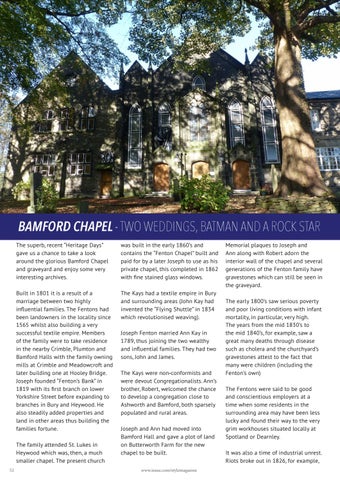BAMFORD CHAPEL - TWO WEDDINGS, BATMAN AND A ROCK STAR The superb, recent “Heritage Days” gave us a chance to take a look around the glorious Bamford Chapel and graveyard and enjoy some very interesting archives.
was built in the early 1860’s and contains the “Fenton Chapel” built and paid for by a later Joseph to use as his private chapel, this completed in 1862 with fine stained glass windows.
Built in 1801 it is a result of a marriage between two highly influential families. The Fentons had been landowners in the locality since 1565 whilst also building a very successful textile empire. Members of the family were to take residence in the nearby Crimble, Plumton and Bamford Halls with the family owning mills at Crimble and Meadowcroft and later building one at Hooley Bridge. Joseph founded “Fenton’s Bank” in 1819 with its first branch on lower Yorkshire Street before expanding to branches in Bury and Heywood. He also steadily added properties and land in other areas thus building the families fortune.
The Kays had a textile empire in Bury and surrounding areas (John Kay had invented the “Flying Shuttle” in 1834 which revolutionised weaving).
The family attended St. Lukes in Heywood which was, then, a much smaller chapel. The present church 52
Joseph Fenton married Ann Kay in 1789, thus joining the two wealthy and influential families. They had two sons, John and James. The Kays were non-conformists and were devout Congregationalists. Ann’s brother, Robert, welcomed the chance to develop a congregation close to Ashworth and Bamford, both sparsely populated and rural areas. Joseph and Ann had moved into Bamford Hall and gave a plot of land on Butterworth Farm for the new chapel to be built. www.issuu.com/stylemagazine
Memorial plaques to Joseph and Ann along with Robert adorn the interior wall of the chapel and several generations of the Fenton family have gravestones which can still be seen in the graveyard. The early 1800’s saw serious poverty and poor living conditions with infant mortality, in particular, very high. The years from the mid 1830’s to the mid 1840’s, for example, saw a great many deaths through disease such as cholera and the churchyard’s gravestones attest to the fact that many were children (including the Fenton’s own) The Fentons were said to be good and conscientious employers at a time when some residents in the surrounding area may have been less lucky and found their way to the very grim workhouses situated locally at Spotland or Dearnley. It was also a time of industrial unrest. Riots broke out in 1826, for example,










